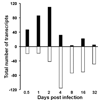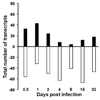Time series analysis of the transcriptional responses of Biomphalaria glabrata throughout the course of intramolluscan development of Schistosoma mansoni and Echinostoma paraensei
- PMID: 20083115
- PMCID: PMC2866805
- DOI: 10.1016/j.ijpara.2009.12.005
Time series analysis of the transcriptional responses of Biomphalaria glabrata throughout the course of intramolluscan development of Schistosoma mansoni and Echinostoma paraensei
Abstract
Successful colonization of a compatible snail host by a digenetic trematode miracidium initiates a complex, proliferative development program requiring weeks to reach culmination in the form of production of cercariae which, once started, may persist for the remainder of the life span of the infected snail. How are such proliferative and invasive parasites able to circumvent host defenses and establish chronic infections? Using a microarray designed to monitor the internal defense and stress-related responses of the freshwater snail Biomphalaria glabrata, we have undertaken a time course study to monitor snail responses following exposure to two different trematode species to which the snail is susceptible: the medically important Schistosoma mansoni, exemplifying sporocyst production in its larval development, or Echinostoma paraensei, representing an emphasis on rediae production in its larval development. We sampled eight time points (0.5, 1, 2, 4, 8, 16 and 32 days p.i.) that cover the period required for cercariae to be produced. Following exposure to S. mansoni, there was a preponderance of up-regulated over down-regulated array features through 2 days p.i. but by 4 days p.i. and thereafter, this pattern was strongly reversed. For E. paraensei, there was a preponderance of down-regulated array features over up-regulated features at even 0.5 days p.i., a pattern that persists throughout the course of infection except for 1 day p.i., when up-regulated array features slightly outnumbered down-regulated features. Examination of particular array features revealed several that were up-regulated by both parasites early in the course of infection and one, fibrinogen related protein 4 (FREP 4), that remained significantly elevated throughout the course of infection with either parasite, effectively serving as a marker of infection. Many defense-related transcripts were persistently down-regulated, including several fibrinogen-containing lectins and homologs of molecules best known from vertebrate phagocytic cells. Our results are consistent with earlier studies suggesting that both parasites are able to interfere with host defense responses, including a tendency for E. paraensei to do so more rapidly and strongly than S. mansoni. They further suggest mechanisms for how trematodes are able to establish the chronic infections necessary for their continued success.
(c) 2010 Australian Society for Parasitology Inc. Published by Elsevier Ltd. All rights reserved.
Figures




Similar articles
-
Differential transcriptomic responses of Biomphalaria glabrata (Gastropoda, Mollusca) to bacteria and metazoan parasites, Schistosoma mansoni and Echinostoma paraensei (Digenea, Platyhelminthes).Mol Immunol. 2010 Jan;47(4):849-60. doi: 10.1016/j.molimm.2009.10.019. Epub 2009 Dec 3. Mol Immunol. 2010. PMID: 19962194 Free PMC article.
-
Different metazoan parasites, different transcriptomic responses, with new insights on parasitic castration by digenetic trematodes in the schistosome vector snail Biomphalaria glabrata.BMC Genomics. 2024 Jun 17;25(1):608. doi: 10.1186/s12864-024-10454-4. BMC Genomics. 2024. PMID: 38886647 Free PMC article.
-
The effect of early infection with Echinostoma paraensei on the interaction of Schistosoma mansoni with Biomphalaria glabrata and Biomphalaria tenagophila.Mem Inst Oswaldo Cruz. 2010 Jul;105(4):499-503. doi: 10.1590/s0074-02762010000400026. Mem Inst Oswaldo Cruz. 2010. PMID: 20721499
-
Epigenetic modulation, stress and plasticity in susceptibility of the snail host, Biomphalaria glabrata, to Schistosoma mansoni infection.Int J Parasitol. 2016 Jun;46(7):389-94. doi: 10.1016/j.ijpara.2016.03.003. Epub 2016 Apr 4. Int J Parasitol. 2016. PMID: 27056272 Review.
-
Immuno-molecular profile for Biomphalaria glabrata/Schistosoma mansoni interaction.Dev Comp Immunol. 2024 Jan;150:105083. doi: 10.1016/j.dci.2023.105083. Epub 2023 Oct 17. Dev Comp Immunol. 2024. PMID: 37852455 Review.
Cited by
-
Biomphalaria glabrata immunity: Post-genome advances.Dev Comp Immunol. 2020 Mar;104:103557. doi: 10.1016/j.dci.2019.103557. Epub 2019 Nov 21. Dev Comp Immunol. 2020. PMID: 31759924 Free PMC article. Review.
-
Status Quo and Future Perspectives of Molecular and Genomic Studies on the Genus Biomphalaria-The Intermediate Snail Host of Schistosoma mansoni.Int J Mol Sci. 2023 Mar 3;24(5):4895. doi: 10.3390/ijms24054895. Int J Mol Sci. 2023. PMID: 36902324 Free PMC article. Review.
-
Allelic variation in a single genomic region alters the hemolymph proteome in the snail Biomphalaria glabrata.Fish Shellfish Immunol. 2019 May;88:301-307. doi: 10.1016/j.fsi.2019.02.065. Epub 2019 Mar 6. Fish Shellfish Immunol. 2019. PMID: 30849501 Free PMC article.
-
Compatibility polymorphism in snail/schistosome interactions: From field to theory to molecular mechanisms.Dev Comp Immunol. 2012 May;37(1):1-8. doi: 10.1016/j.dci.2011.09.002. Epub 2011 Sep 16. Dev Comp Immunol. 2012. PMID: 21945832 Free PMC article. Review.
-
Genomic and transcriptional analysis of genes containing fibrinogen and IgSF domains in the schistosome vector Biomphalaria glabrata, with emphasis on the differential responses of snails susceptible or resistant to Schistosoma mansoni.PLoS Negl Trop Dis. 2020 Oct 14;14(10):e0008780. doi: 10.1371/journal.pntd.0008780. eCollection 2020 Oct. PLoS Negl Trop Dis. 2020. PMID: 33052953 Free PMC article.
References
-
- Abrous M, Rondelaud D, Dreyfuss G, Cabaret J. Unusual transmission of the liver fluke, Fasciola hepatica, by Lymnaea glabra or Planorbis leucostoma in France. J Parasitol. 1998;84:1257–1259. - PubMed
-
- Adema CM, Arguello DF, 2nd, Stricker SA, Loker ES. A time-lapse study of interactions between Echinostoma paraensei intramolluscan larval stages and adherent hemocytes from Biomphalaria glabrata and Helix aspersa. J Parasitol. 1994;80:719–727. - PubMed
-
- Adema CM, Hanington PC, Rosenberg GH, Aragon AD, Stout BA, Lennard Richard ML, Gross PS, Loker ES. Differential transcriptomic responses of Biomphalaria glabrata (Gastropoda, Mollusca) to bacteria and metazoan parasites Schistosoma mansoni and Echinostoma paraensei (Digenea, Platyhelminthes) Mol Immunol. In press. - PMC - PubMed
-
- Appleton CC. Studies on Austrobilharzia terrigalensis (Trematoda: Schistosomatidae) in the Swan Estuary, Western Australia: infection in the definitive host, Larus novaehollandiae. Int J Parasitol. 1983;13:249–259. - PubMed
Publication types
MeSH terms
Grants and funding
LinkOut - more resources
Full Text Sources
Molecular Biology Databases
Research Materials

